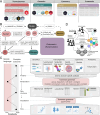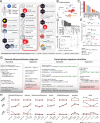This is a preprint.
The tidyomics ecosystem: Enhancing omic data analyses
- PMID: 38826347
- PMCID: PMC11142095
- DOI: 10.1101/2023.09.10.557072
The tidyomics ecosystem: Enhancing omic data analyses
Update in
-
The tidyomics ecosystem: enhancing omic data analyses.Nat Methods. 2024 Jul;21(7):1166-1170. doi: 10.1038/s41592-024-02299-2. Epub 2024 Jun 14. Nat Methods. 2024. PMID: 38877315
Abstract
The growth of omic data presents evolving challenges in data manipulation, analysis, and integration. Addressing these challenges, Bioconductor1 provides an extensive community-driven biological data analysis platform. Meanwhile, tidy R programming2 offers a revolutionary standard for data organisation and manipulation. Here, we present the tidyomics software ecosystem, bridging Bioconductor to the tidy R paradigm. This ecosystem aims to streamline omic analysis, ease learning, and encourage cross-disciplinary collaborations. We demonstrate the effectiveness of tidyomics by analysing 7.5 million peripheral blood mononuclear cells from the Human Cell Atlas3, spanning six data frameworks and ten analysis tools.
Conflict of interest statement
Competing interest R.G. has received consulting income from Takeda and Sanofi, and declares ownership in Ozette Technologies. M.K. is an employee of and declares ownership in Achilles Therapeutics. The remaining authors declare no competing interests.
Figures


References
-
- Wickham H. et al. Welcome to the Tidyverse. Journal of Open Source Software 4, 1686 (2019).
-
- Tarazona S., Arzalluz-Luque A. & Conesa A. Undisclosed, unmet and neglected challenges in multi-omics studies. Nature Computational Science 1, 395–402 (2021). - PubMed
-
- Li P. Computation and Visualization of Package Download Counts and Percentiles [R package packageRank version 0.8.3]. (2023).
Methods references
-
- Rozenblatt-Rosen O. et al. Building a high-quality Human Cell Atlas. Nat. Biotechnol. 39, 149–153 (2021). - PubMed
Publication types
Grants and funding
LinkOut - more resources
Full Text Sources
